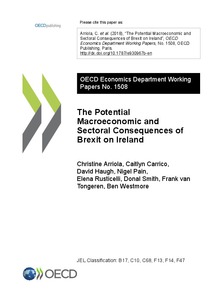The potential macroeconomic and sectoral consequences of Brexit on Ireland
"This paper provides estimates of the potential effects on exports, imports, production, factor demand and GDP in Ireland of an exit of the United Kingdom (UK) from the European Union (EU), focusing on trade and FDI channels. Owing to the high uncertainty regarding the final trade agreement bet...
| Main Authors: | , , , , , , , |
|---|---|
| Institution: | ETUI-European Trade Union Institute |
| Format: | TEXT |
| Language: | English |
| Published: |
Paris
2018
OECD |
| Subjects: | |
| Online Access: | https://www.labourline.org/KENTIKA-19303692124911218749-The-potential-macroeconomic-an.htm |
| _version_ | 1771659897111314433 |
|---|---|
| author | Arriola, Christine Carrico, Caitlyn Haugh, David Pain, Nigel Rusticelli, Elena Smith, Donal van Tongeren, Frank Westmore, Ben |
| author_facet | Arriola, Christine Carrico, Caitlyn Haugh, David Pain, Nigel Rusticelli, Elena Smith, Donal van Tongeren, Frank Westmore, Ben |
| collection | Library items |
| description | "This paper provides estimates of the potential effects on exports, imports, production, factor demand and GDP in Ireland of an exit of the United Kingdom (UK) from the European Union (EU), focusing on trade and FDI channels. Owing to the high uncertainty regarding the final trade agreement between the negotiating parties, the choice has been made to assume a worst-case outcome where trade relations between the United Kingdom and EU are governed by World Trade Organization (WTO) most favoured nation (MFN) rules. In doing so, it provides something close to an upper bound estimate of the negative economic impact taking into account the potential for some firms to relocate to Ireland. Any final trade agreement that would result in closer relationships between the United Kingdom and the EU could reduce this negative impact. The simulations use two large-scale models: a global macroeconomic model (NiGEM) and a general equilibrium trade model (METRO). These models are used to quantify, both at the macroeconomic and the sectoral level, two key channels through which Ireland would be affected: trade and foreign direct investment. The simulation results highlight that the negative effect on trade could result in Ireland's GDP falling by 1½ per cent in the medium-term and around 2½ per cent in the long-term. The impacts are highly heterogeneous across sectors. Agriculture, food, and some smaller manufacturing sectors experience the largest declines in total gross exports at over 15%. By contrast, financial services exports increase slightly. The modelling suggests that any positive offsetting impact to the trade shock from increased inward FDI to Ireland is likely to be modest." |
| format | TEXT |
| geographic | Ireland |
| id | 19303692124911218749_a830af129aac40e0b77e0020ea04bedc |
| institution | ETUI-European Trade Union Institute |
| is_hierarchy_id | 19303692124911218749_a830af129aac40e0b77e0020ea04bedc |
| is_hierarchy_title | The potential macroeconomic and sectoral consequences of Brexit on Ireland |
| language | English |
| physical | 39 p. Digital |
| publishDate | 2018 |
| publisher | Paris OECD |
| spellingShingle | Arriola, Christine Carrico, Caitlyn Haugh, David Pain, Nigel Rusticelli, Elena Smith, Donal van Tongeren, Frank Westmore, Ben Brexit economic implication macroeconomics trade foreign investment The potential macroeconomic and sectoral consequences of Brexit on Ireland |
| thumbnail | https://www.labourline.org/Image_prev.jpg?Archive=136016895429 |
| title | The potential macroeconomic and sectoral consequences of Brexit on Ireland |
| topic | Brexit economic implication macroeconomics trade foreign investment |
| url | https://www.labourline.org/KENTIKA-19303692124911218749-The-potential-macroeconomic-an.htm |

